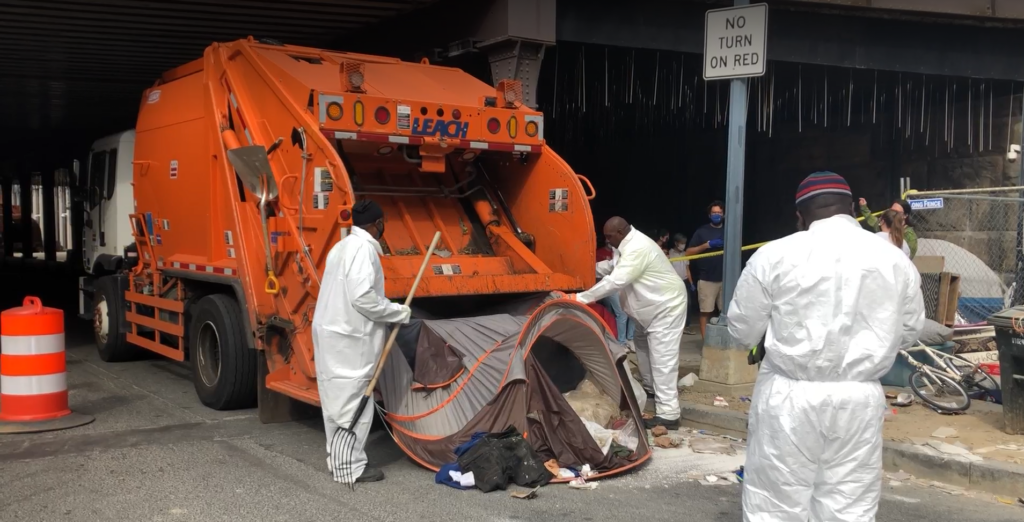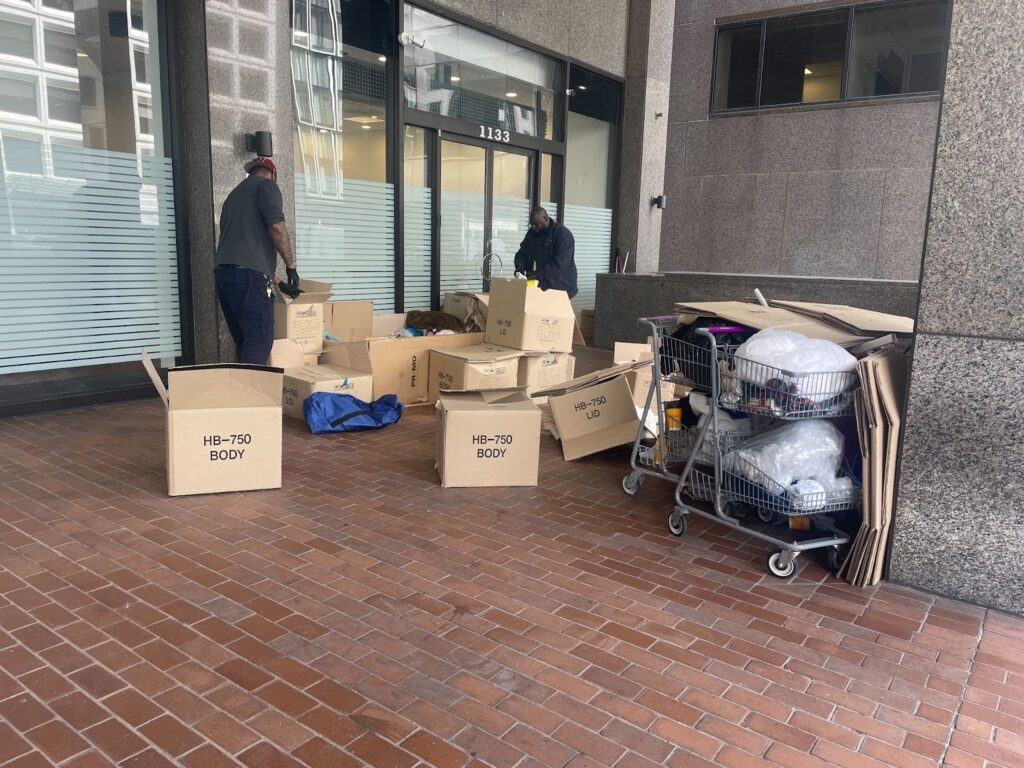The eviction of tent encampment residents from the underpasses on L and M Streets NE near Union Station was suspended for less than 24 hours, after a city worker used a small front loader Monday to lift a tent with an individual still inside, pushing the person over a guardrail and into the street.
The individual was taken from the underpass in an ambulance after receiving medical attention on site. They were conscious but appeared to not be able to put weight on one leg while they were being led to the ambulance. The Office of the Deputy Mayor for Health and Human Services (DMHHS) did not respond to an inquiry about the person’s health the next day.
Residents told Marissa Lang from the Washington Post that the individual returned Monday night and seemed OK.
Approximately 12 tents remained at the L Street underpass Monday afternoon, and the M Street underpass had four tents remaining. Some encampment residents moved ahead of the cleanup date. According to a statement Monday evening, DMHHS had “facilitated housing leases for up 22 participants.” Others found new areas to pitch their tents.
Deputy Mayor Wayne Turnage said in the statement Monday evening that outreach staff had conducted “multiple checks” on the tent but that “unbeknown to us, a resident was still inside.” According to his office’s encampment protocol, the Department of Human Services is responsible for making “reasonable efforts” to identify and store property of “apparent value” before an encampment area is cleaned up — including personal identification, personal photos, documents “of obvious importance,” and medications — even if they are unattended.
“Due to that incident, we decided to suspend further activity for the day,” Turnage said in the statement.
After the incident, mutual aid workers began to yell at police, which led officers to move them out of the underpass. Some continued to yell at police about the incident and one officer shoved two mutual aid workers. A mutual aid volunteer who refused to leave was dragged out of the underpass.
Once the person in the tent was taken away in the ambulance, police and city workers dispersed. The front loader and garbage trucks left and most tents were roped off with caution tape and surrounded by orange traffic cones.
Prior to the encampment evictions at NoMa, the area contained posted notices that said the sidewalks would become designated “pedestrian passageways” after the cleanups.
When all was said and done, both the sidewalks in the M Street NE and L Street NE underpasses were “ to not have any form of obstructions or belongings or encampment or anything that may force pedestrians to have to walk out in the street,” DMHHS’s encampment coordinator, Jamal Weldon, said during a Sept. 22 community meeting about the new policy.
However, D.C. workers replaced the orange cones with concrete barriers Monday night. They also placed a “Sidewalk Closed” sign along the north side of the M Street underpass sometime Tuesday.
Some councilmembers expressed concerns about DMHHS’s handling of the cleanup, particularly over the person picked up and injured by construction equipment.
“One of the reasons that we do not disassemble encampments is because there are risks involved. There are risks involved in asking people to move all of their belongings and risks involved in forcibly removing people from their home,” Ward 1 Councilmember Brianne Nadeau tweeted. While only one other encampment location has been closed permanently by the District (the nearby K Street underpass in January 2020), DMHHS has conducted at least 30 “full cleanups” this year, according to Street Sense Media’s monitoring of the DMHHS cleanup calendar.
DMHHS did not respond to Street Sense Media’s inquiries about when it would resume the eviction, but Turnage told WTOP the city has changed how machines will be used during cleanups. “There will be a check to make sure there is absolutely nobody in that tent, and then a person will stand there while the Bobcat comes to make sure nobody comes in the tent after the check is made,” Turnage told WTOP.
Ward 4 Councilmember Janeese Lewis George tweeted that no one should have been removed and that the closure should be “immediately paused until every resident is fully and permanently housed.”
However, a front loader was back clearing tents on L Street late Tuesday morning to finish the job.
Ward 6 Councilmember Charles Allen, who represents NoMa residents, told WTOP he would like to see workers check each tent and only use the machines at the end with large items and biohazards.
“This is the mayor’s pilot program to help move people in[side],” Allen told WTOP. “And while it holds some potential, we’ve got to have accountability for every step of the process.”
The encampment closure is part of an initiative the District said will house individuals and address public health concerns. However, encampment residents and advocates have raised concerns with the timeline of the program and questioned why the encampments must be closed for some people to be housed.
DMHHS officials have said that through the Coordinated Assistance and Resources for Encampments (CARE) pilot program, residents would be placed in housing for up to one year using unspecified “local funds.” They would then be given services to help connect them to other housing programs, such as Permanent Supportive Housing, Rapid Rehousing, or Targeted Affordable Housing.
For this and previous Street Sense Media stories following the new initiative, DMHHS repeatedly ignored questions about the cleanup. The office did not respond to questions regarding the cost of a full cleanup, a time estimate for someone to acquire support through other housing programs, and the source of the funds for the one-year apartment leases.
When asked if pilot program participants would be prioritized ahead of people already waiting for housing assistance, the Department of Human Services said in a statement “living outside does not increase chances for obtaining a voucher sooner” but that anyone who is chronically homeless, whether they are in shelters, PEP-V, or encampments, will be prioritized.
The Way Home Campaign, a group of more than 100 organizations and 6,000 individuals looking to end chronic homelessness in D.C., called the program “part of D.C.’s crackdown on visible homelessness” in a statement Monday.
[Disclosure: Street Sense Media, our publisher, is a member of the Way Home Campaign. The organization’s advocacy efforts do not influence our reporting or infringe on our editorial independence.]
“While we are thrilled to see a whole-of-government approach working to urgently end homelessness for encampment residents, we believe this approach must be applied to everybody, not just those living in politically inconvenient encampments,” The Way Home Campaign wrote.
As of Monday, Turnage said there were eight more people in the process of moving into housing in addition to the 22 people he said had leases facilitated by DMHHS.
“Participants who are eligible will be offered the Pandemic Emergency Program for Medically Vulnerable Adults (PEP-V) stays in the meantime,” Turnage said in the statement, although it’s unclear who specifically will receive a bed in a hotel room through the program, which was established as a “non-congregate” shelter option for unhoused people who are especially vulnerable to COVID-19.
Charles Willie, who has lived at L and M Streets for 14 years, refused to move his M Street home Monday morning. Willie and a few other M Street residents were able to leave their belongings as of Monday afternoon.
“I have my voucher. I’ve been in front of the judge. I’ve met my landlord. I’ve signed my lease,” Willie said. “Brand-new building has been erected. They had to get two inspections. One’s done, they’re waiting on the last inspection. I’ve just got a week left.”
It’s unclear how many people in the NoMa encampments were on the “by-name list” DMHHS is using to guide housing for the pilot program, or how many had obtained housing before the cleanup. Encampment residents had to sign the list by Aug. 23 to be eligible for the program. DMHHS did not provide answers to these questions.
Some residents who did not receive housing were recommended by Pathways to Housing to move to an encampment at a park at New Jersey Avenue and O Street NW so they could stay connected with outreach workers.
That encampment is also targeted by the DMHHS pilot program, and it’s set to close by Nov. 4 for renovation. When Street Sense Media reported the eventual closure in June, before the pilot program had been announced, many housed residents in the area had complained about the number of unhoused people living there and the lack of resources for them. A fire broke out at one of the tents Monday night, killing one person who was inside, according to D.C. Fire and EMS.
In addition to the NoMa underpasses and the park at New Jersey and O, an encampment along E Street NW in Foggy Bottom is expected to undergo the same permanent closure coupled with the promise of housing for some. However, the Foggy Bottom encampment is under both D.C. and National Park Service jurisdiction, so DMHHS officials haven’t announced a closure date for that location yet.
These encampments were chosen for the pilot because they are some of the largest in the city, according to DMHHS officials, which the agency said makes them each a health and safety risk.
“When you’re living in a public encampment, we can do the best we can to send trash pickups to pick up biohazards. But we can’t be there 24/7,” Turnage said during the Sept. 22 community meeting. “There’s no reason for people to live like that.”
A major motivation for the pilot program was to ensure that at least 80 to 100 people could get housed before the hypothermia season, Jamal Weldon, the DMHHS encampment coordinator, said during a D.C. Interagency Council on Homelessness Emergency Response and Shelter Operations committee held earlier on the same day as the community meeting.
But advocates and people experiencing homelessness have questioned the closures in light of the pandemic. The Centers for Disease Control and Prevention recommends allowing people living in encampments to remain where they are to prevent the further spread of COVID-19.
“Clearing encampments can cause people to disperse throughout the community and break connections with service providers. This increases the potential for infectious disease spread,” CDC guidance says.
Willie, the long-time resident of M and L Street now waiting on housing, also said they aren’t supposed to move because of COVID-19. He defended his presence, pointing out that he maintains the area around his tent.
“It’s crazy. I’ve been out here 14 years, man. I’ve got another four days left, or a week left,” Willie said. “We’re not supposed to be moving anything because of COVID. They put … mouse traps and poisons and stuff. We already pulling our trash out. It’s like there’s no reason for all this stuff going on. They’re trying to get people to move their tents so they can barricade it.”








